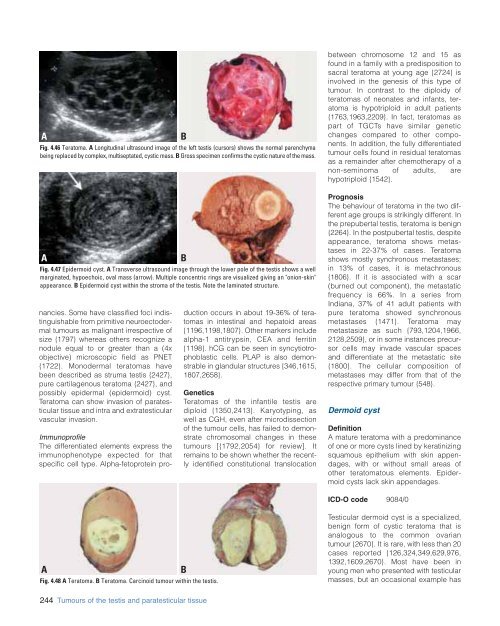CHAPTER X CHAPTER 4 - Cancer et environnement
CHAPTER X CHAPTER 4 - Cancer et environnement
CHAPTER X CHAPTER 4 - Cancer et environnement
Create successful ePaper yourself
Turn your PDF publications into a flip-book with our unique Google optimized e-Paper software.
A<br />
Fig. 4.46 Teratoma. A Longitudinal ultrasound image of the left testis (cursors) shows the normal parenchyma<br />
being replaced by complex, multiseptated, cystic mass. B Gross specimen confirms the cystic nature of the mass.<br />
A<br />
Fig. 4.47 Epidermoid cyst. A Transverse ultrasound image through the lower pole of the testis shows a well<br />
marginated, hypoechoic, oval mass (arrow). Multiple concentric rings are visualized giving an "onion-skin"<br />
appearance. B Epidermoid cyst within the stroma of the testis. Note the laminated structure.<br />
nancies. Some have classified foci indistinguishable<br />
from primitive neuroectodermal<br />
tumours as malignant irrespective of<br />
size {1797} whereas others recognize a<br />
nodule equal to or greater than a (4x<br />
objective) microscopic field as PNET<br />
{1722}. Monodermal teratomas have<br />
been described as struma testis {2427},<br />
pure cartilagenous teratoma {2427}, and<br />
possibly epidermal (epidermoid) cyst.<br />
Teratoma can show invasion of paratesticular<br />
tissue and intra and extratesticular<br />
vascular invasion.<br />
B<br />
B<br />
Immunoprofile<br />
The differentiated elements express the<br />
immunophenotype expected for that<br />
specific cell type. Alpha-f<strong>et</strong>oprotein production<br />
occurs in about 19-36% of teratomas<br />
in intestinal and hepatoid areas<br />
{1196,1198,1807}. Other markers include<br />
alpha-1 antitrypsin, CEA and ferritin<br />
{1198}. hCG can be seen in syncytiotrophoblastic<br />
cells. PLAP is also demonstrable<br />
in glandular structures {346,1615,<br />
1807,2658}.<br />
Gen<strong>et</strong>ics<br />
Teratomas of the infantile testis are<br />
diploid {1350,2413}. Karyotyping, as<br />
well as CGH, even after microdissection<br />
of the tumour cells, has failed to demonstrate<br />
chromosomal changes in these<br />
tumours [{1792,2054} for review]. It<br />
remains to be shown wh<strong>et</strong>her the recently<br />
identified constitutional translocation<br />
b<strong>et</strong>ween chromosome 12 and 15 as<br />
found in a family with a predisposition to<br />
sacral teratoma at young age {2724} is<br />
involved in the genesis of this type of<br />
tumour. In contrast to the diploidy of<br />
teratomas of neonates and infants, teratoma<br />
is hypotriploid in adult patients<br />
{1763,1963,2209}. In fact, teratomas as<br />
part of TGCTs have similar gen<strong>et</strong>ic<br />
changes compared to other components.<br />
In addition, the fully differentiated<br />
tumour cells found in residual teratomas<br />
as a remainder after chemotherapy of a<br />
non-seminoma of adults, are<br />
hypotriploid {1542}.<br />
Prognosis<br />
The behaviour of teratoma in the two different<br />
age groups is strikingly different. In<br />
the prepubertal testis, teratoma is benign<br />
{2264}. In the postpubertal testis, despite<br />
appearance, teratoma shows m<strong>et</strong>astases<br />
in 22-37% of cases. Teratoma<br />
shows mostly synchronous m<strong>et</strong>astases;<br />
in 13% of cases, it is m<strong>et</strong>achronous<br />
{1806}. If it is associated with a scar<br />
(burned out component), the m<strong>et</strong>astatic<br />
frequency is 66%. In a series from<br />
Indiana, 37% of 41 adult patients with<br />
pure teratoma showed synchronous<br />
m<strong>et</strong>astases {1471}. Teratoma may<br />
m<strong>et</strong>astasize as such {793,1204,1966,<br />
2128,2509}, or in some instances precursor<br />
cells may invade vascular spaces<br />
and differentiate at the m<strong>et</strong>astatic site<br />
{1800}. The cellular composition of<br />
m<strong>et</strong>astases may differ from that of the<br />
respective primary tumour {548}.<br />
Dermoid cyst<br />
Definition<br />
A mature teratoma with a predominance<br />
of one or more cysts lined by keratinizing<br />
squamous epithelium with skin appendages,<br />
with or without small areas of<br />
other teratomatous elements. Epidermoid<br />
cysts lack skin appendages.<br />
ICD-O code 9084/0<br />
A<br />
Fig. 4.48 A Teratoma. B Teratoma. Carcinoid tumour within the testis.<br />
B<br />
Testicular dermoid cyst is a specialized,<br />
benign form of cystic teratoma that is<br />
analogous to the common ovarian<br />
tumour {2670}. It is rare, with less than 20<br />
cases reported {126,324,349,629,976,<br />
1392,1609,2670}. Most have been in<br />
young men who presented with testicular<br />
masses, but an occasional example has<br />
244 Tumours of the testis and paratesticular tissue
















